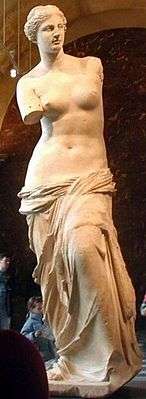S Curve (art)
The S Curve is a traditional art concept in Ancient Greek sculpture and Roman sculpture where the figure's body and posture is depicted like a sinuous or serpentine "S". It is related to and is an extension of the art term of contrapposto which is when a figure is depicted slouching or placing one's weight and thus center of gravity to one side. However, the S Curve involves more of the body than the contrapposto, and is therefore considered to be a more advanced technical development. The "S Curve" concept was initiated by famous Greek sculptor Praxiteles, son of Kifissodotos.[1]
- Examples of S Curve and Contrapposto
-

The Venus de Milo depicts a S Curve body shape
-

Note that there is only a slight weight shift in the Kritios Boy; thus, it is a contrapposto.
See also
References
- ↑ "Art Of Ancient Greece, Brief History (1050- 50 b.C.), Georgia Kokkorou- Aleyra
This article is issued from Wikipedia - version of the 7/18/2016. The text is available under the Creative Commons Attribution/Share Alike but additional terms may apply for the media files.